The Living "Old Glory"
Flag Day, June 14, 2023 - Since Betsy Ross sewed together the first stars and stripes, the flag of the United States of America has done something that happens rarely to other national flags. It has changed. Not only has it undergone a change, it has undergone twenty-six changes, starting with the 1795 addition of two more stars (and stripes) representing Vermont and Kentucky.
Starting with Flag Day 2023, and continuing until Flag Day 2024, the HHS website will feature an official flag design of each of those 26 changes, along with a short summary of what was going on during its tenure, including those who served as Hamden's first selectmen and mayors. Several designs had a very short tenure - just one year - as did our 49-star flag from 1959 to 1960, that bridged the tenures of the second longest and longest designs.
|
_______________________________________________________________________________________________________
|
30 Stars
(July 4, 1848 - July 3, 1851)
|
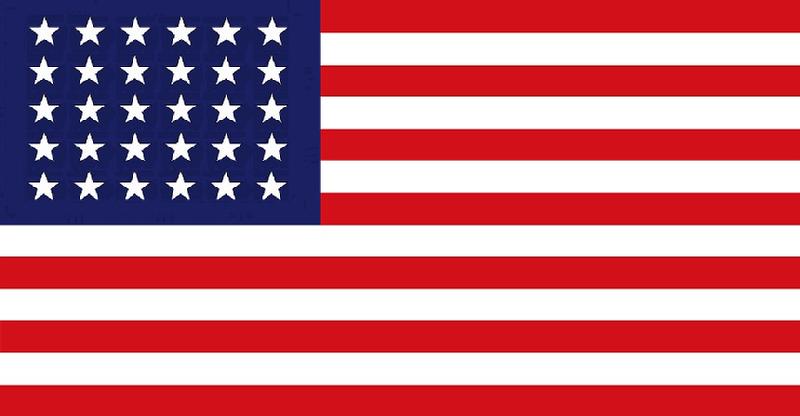 |
| Wisconsin admitted May 29, 1848 |
|
|
Between July 4, 1848 and July 3, 1851:
Hamden Fire Selectmen: Jesse Mansfield (1846) Rufus Dorman (1849-50)
Griswold Gilbert (1851)
|
_______________________________________________________________________________________________________
|
29 Stars
(July 4, 1847 - July 3, 1848)
|
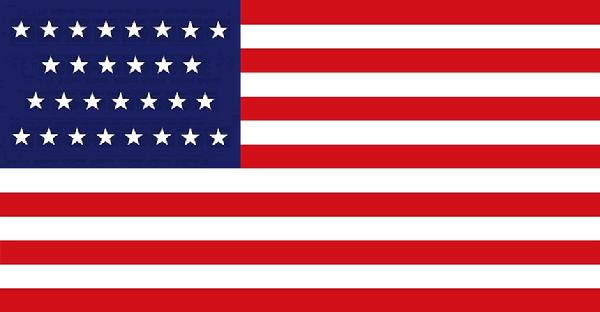 |
| Iowa (December 28, 1846) |
|
|
Between July 4, 1846 and July 3, 1848:
- December 1846 - The Donner Party, a party of American settlers in wagon trains, became stranded in the snow-covered Sierra Nevada Mountains in California and resorted to cannibalism to survive.
- February 22, 1847 - U.S. troops commanded by General Zachary Taylor defeated a Mexican Army at the Battle of Buena Vista in the Mexican War.
- March 29, 1847 - U.S. troops commanded by General Winfield Scott captured Veracruz in the Mexican War.
- June 1, 1847 - Cornelius Vanderbilt, one of America's richest and most competitive men, raced a steamboat against rival Daniel Drew in the Hudson River. Many thousands of New Yorkers lined the city's docks to watch the paddle wheelers race.
Hamden First Selectmen: Harvey Bradley (1846) and Henry Munson (1847)
- Some of this information obtained from Wikipedia -
|
_______________________________________________________________________________________________________
|
28 Stars
(July 4, 1846 - July 3, 1847)
|
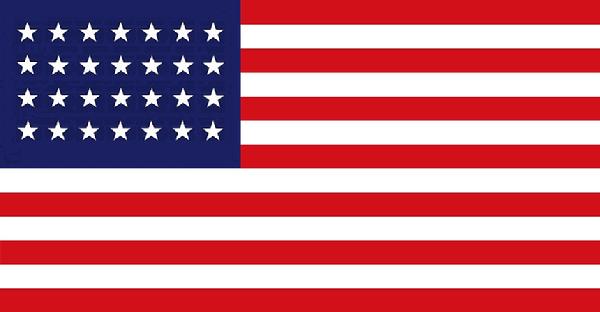 |
| Texas (December 29, 1845) |
|
|
Between July 4, 1846 and July 3, 1848:
- December 1846 - The Donner Party, a party of American settlers in wagon trains, became stranded in the snow-covered Sierra Nevada Mountains in California and resorted to cannibalism to survive.
- February 22, 1847 - U.S. troops commanded by General Zachary Taylor defeated a Mexican Army at the Battle of Buena Vista in the Mexican War.
- March 29, 1847 - U.S. troops commanded by General Winfield Scott captured Veracruz in the Mexican War.
- June 1, 1847 - Cornelius Vanderbilt, one of America's richest and most competitive men, raced a steamboat against rival Daniel Drew in the Hudson River. Many thousands of New Yorkers lined the city's docks to watch the paddle wheelers race.
Hamden First Selectmen: Harvey Bradley (1846) and Henry Munson (1847)
- Some of this information obtained from Wikipedia -
|
_______________________________________________________________________________________________________
|
27 Stars
(July 4, 1845 - July 3, 1846)
|
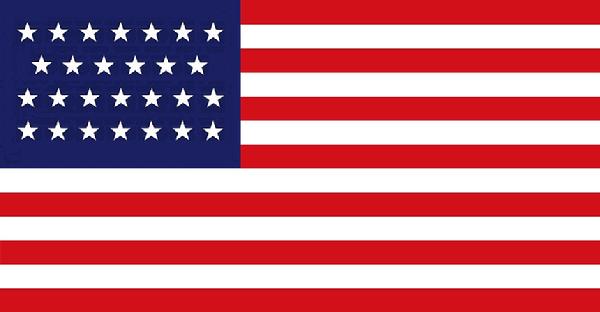 |
| Florida (March 3, 1845) |
|
|
Between July 4, 1845 and July 3, 1846:
- July 4, 1845 – Near Concord, Massachusetts, Henry David Thoreau embarks on a 2-year experiment in simple living at Walden Pond.
- July 19 – Great New York City Fire of 1845 breaks out in Lower Manhattan.
- July–August – In the United States Magazine and Democratic Review editor John L. O'Sullivan declares that foreign powers are trying to prevent American annexation of Texas in order to impede "the fulfillment [sic] of our manifest destiny to overspread the continent allotted by Providence for the free development of our yearly multiplying millions," [2] the first use of the phrase "Manifest Destiny."
- August 28 – The journal Scientific American begins publication.
- October 10 – In Annapolis, Maryland, the Best School (later renamed the United States Naval Academy) opens with 50 midshipmen students and 7 professors.
- October 13 – A majority of voters in the Republic of Texas approve a proposed constitution, that if accepted by the United States Congress, will make Texas a U.S. state.
- October 21 – The New York Herald becomes the first newspaper to mention the game of baseball.
- October 22 – The New York Morning News becomes the first newspaper to include a box-score of a baseball game.
- December 2 – Manifest Destiny: U.S. President James K. Polk announces to Congress that the Monroe Doctrine should be strictly enforced and that the United States should aggressively expand into the West.
- December 5 – The Templars of Honor and Temperance is founded in the United States.
- December 27 - Anesthesia is used for childbirth for the first time (Dr. Crawford Long in Jefferson, Georgia). American journalist John L. O'Sullivan claims in a newspaper article (in connection with the annexation of the Oregon Country) that the United States has a "Manifest Destiny" to expand its borders, the second time he uses the term; it will have a huge influence on the American imperialistic movement of the 19th century.
- December 29 – Texas is admitted as the 28th U.S. state (see History of Texas).
- January 4 – The United States House of Representatives votes to stop sharing the Oregon Territory with the United Kingdom.
- February 11 – Many Mormons begin their migration west from Nauvoo, Illinois to the Great Salt Lake, led by Brigham Young.
- February 18 – In Austin, Texas, the newly formed Texas state government is officially installed.
- February 27 – The Liberty Bell is cracked while being rung for George Washington's birthday.
- April 26 – Mexican–American War: Open conflict begins over border disputes of Texas' boundaries.
- May 8 – Mexican–American War – Battle of Palo Alto: Gen. Zachary Taylor defeats a Mexican force north of the Rio Grande at Palo Alto, Texas in the first major battle of the war.
- May 14 – Mexican–American War: The United States declares war on Mexico.
- May 23 – The Associated Press is founded in New York City.
- June 14 – Mexican–American War: The California Republic declares independence from Mexico.
- June 15 – Bear Flag Revolt: American settlers in Sonoma, California start a rebellion against Mexico and proclaim the California Republic. June 16 – The Oregon Treaty establishes the 49th parallel as the border between the United States and Canada, from the Rocky Mountains to the Strait of Juan de Fuca.
- June 20 – The first officially recorded baseball game using modern rules developed by Alexander Cartwright is played in Hoboken, New Jersey.
Hamden First Selectmen: Abial Leonard (1845) and Harvey Bradley (1846)
- Some of this information obtained from Wikipedia -
|
_______________________________________________________________________________________________________
|
26 Stars
(July 4, 1837 - July 3, 1845)
|
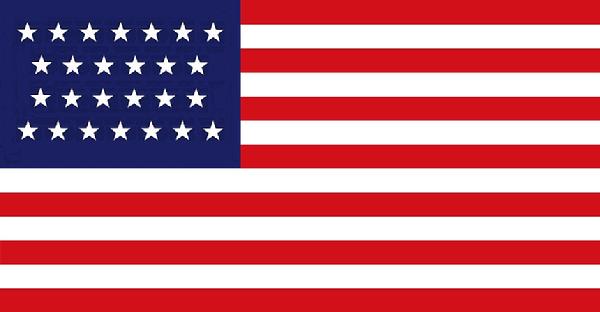 |
| Michigan (January 26, 1837) |
|
|
Between July 4, 1837 and July 3, 1845:
- January 6, 1838 – Samuel Morse first publicly demonstrates the telegraph.
- January 27, 1838 – Abraham Lincoln speaks at the Springfield Young Men's Lyceum
- June 12, 1838 – Iowa Territory is created.
- November 11, 1839 – The Virginia Military Institute is founded in Lexington, Virginia.
- November 7, 1840 – William Henry Harrison defeats Martin Van Buren in 1840 election.
- March 4, 1841 - Pres. William Henry Harrison inaugurated
- April 4, 1841 - Pres. Harrison dies of pneumonia and is succeeded by V.P. John Tyler.
- November 26, 1842 - Notre Dame University founded in South Bend, Indiana.
- December 19, 1843 - A Christmas Carol by Charles Dickens was first published.
- June 15, 1844 – Charles Goodyear receives a patent for vulcanization, a process to strengthen rubber.
- March 3, 1845 - Florida admitted to the Union.
Hamden First Selectmen: Amos Peck (1837), Alfred Bassett (1838), Lewis Warner (1839), James Ford (1840), Peter Van Houton (1841), Lewis Warner (1842), Griswold Gilbert (1843), Horace Potter (1844) and Abial Leonard (1845).
- Some of this information obtained from Wikipedia -
|
_______________________________________________________________________________________________________
|
25 Stars
(July 4, 1836 - July 3, 1837)
|
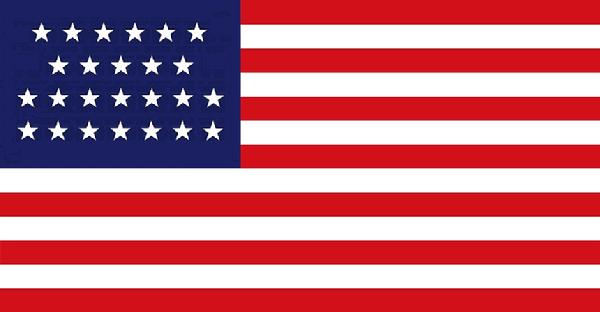 |
| Arkansas (June 15, 1836) |
|
|
Between July 4, 1836 and July 3, 1837:
- August 30, 1836 - City of Houston, Texas founded.
- December 14, 1836 - Toledo War officially ends.
- January 26, 1837 - Michigan admitted mto the Union.
- February 8, 1837 - Richard Johnson becomes first vice president chosen by the Senate.
- March 4, 1837 - Chicago incorporated.
- May 10, 1837 - Panic of 1837; New York City banks fail and unemploymeny at a record high.
- June 20, 1837 - Victoria becomes Queen of United Kingdom.
Hamden First Selectmen: Harvey Bradley (1836) and Amos Peck (1837)
- Some of this information obtained from Wikipedia -
|
_______________________________________________________________________________________________________
|
24 Stars
(July 4, 1822 - July 3, 1836)
|
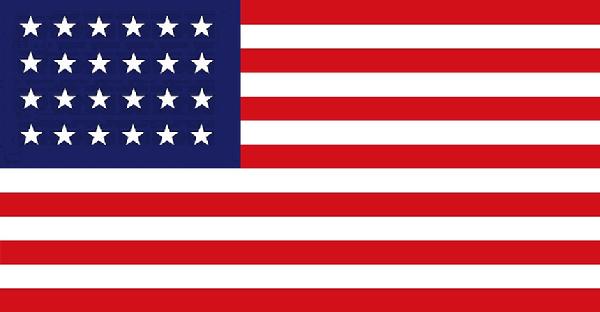 |
| Missouri (August 10, 1821) |
|
|
Significant historical events between July 4, 1822 and July 3, 1836: CLICK HERE
Hamden First Selectmen: Elam Warner (1822), Arba Dickerman (1823), Joel Ford (1824-25), Alfred Basett (1826), Elias Cooper (1827), Allen Dickerman (1828), Roderick Kimberly (1829-30), Leverett Tuttle (1831), Jesse Mansfield (1832-33), Sterling Bradley (1834), Lewis Heaton (1835) and Harvey Bradley (1836).
- Some of this information obtained from Wikipedia -
|
_______________________________________________________________________________________________________
|
23 Stars
13 Stripes
(July 4, 1820 - July 3, 1822)
|
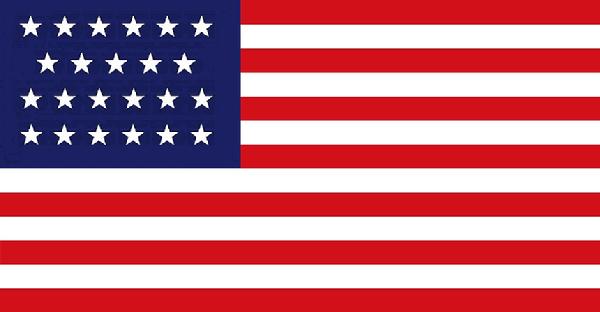 |
| Alabama (Dec. 14, 1819), Maine (March 15, 1820) |
|
|
Between July 4, 1820 and July 3, 1822:
- 1820 – Massachusetts divided in two with the admission of Maine as a state.
- 1820 - James Monroe reelected president unopposed, Daniel D. Tompkins reelected vice president.
- 1821 – Missouri becomes a state
- 1821 – Florida becomes a U.S. territory
Hamden First Selectmen: Allen Dickerman (1820) and Elam Warner (1821-22)
- Some of this information obtained from Wikipedia -
|
_______________________________________________________________________________________________________
|
21 Stars
13 Stripes
(July 4, 1819 - July 3, 1820)
|
 |
| Illinois (December 3, 1818) |
|
|
Between July 4, 1819 and July 3, 1820: July 4th - Arkansas became a territory, and Alabama (Dec. 14th) and Maine (March 15th) were admitted as the 22nd and 23rd states. Other significant events:
Hamden First Selectmen: Lyman Atwater (1819) and Allen Dickerman (1820)
- Some of this information obtained from Wikipedia -
|
_______________________________________________________________________________________________________
|
20 Stars
13 Stripes
(July 4, 1818 - July 3, 1819)
July 4
|
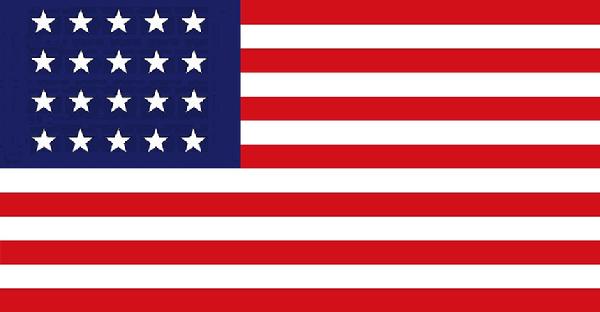 |
| Tennessee (June 1, 1796), Ohio (March 1, 1803), Louisiana (April 30, 1812), Indiana (December 11, 1816), and Mississippi (December 10, 1817) |
|
|
The year after the adoption of the 15-star design, Tennessee was admitted on June 1, 1796, but no change was made to the flag. And no changes came with the admissions of Ohio in 1803, Louisiana in 1812, or Indiana in 1816.
But after Mississippi was admitted on December 10, 1817, bringing the total number of states to 20, Congress decided to enact a new flag policy that mandated an additional star (or stars) be added to the flag at noon on the July 4th following the admission of any new state(s). The number of stripes was also permanently reduced to thirteen to represent the original thirteen colonies that became our first states.
At noon on July 4, 1818, during the first term of President James Monroe, the new 20-star design of four rows of five stars was introduced. Like several other future designs, this flag would be the current design for just one year, but lots of things happened during those 365 days.
On October 20, 1818 the Convention of 1818 between the U.S. and the U.K. was signed, establishing the U.S.-Canadian border at the 49th parallel for most of its length. On December 3rd, Illinois was admitted to the union, guaranteeing a new star on the flag next July 4th.
December 24, 1818 saw the first performance of "Silent Night." On February 17, 1819, the House passed the first Missouri Compromise. The first Trans-Atlantic sailing of a steamship was accomplished, mostly under sail, when the S.S. Savannah steamed into Liverpool on June 20, 1819. On July 3, 1819, the Bank of Savings, the nation's first savings bank, opened in New York City.
Hamden First Selectmen: Zodac Allen (1818) and Lyman Atwater (1819)
|
_______________________________________________________________________________________________________
|
15 Stars
15 Stripes
"The Star-Spangled Banner"
(May 1, 1795 - July 3, 1818)
June 23
|
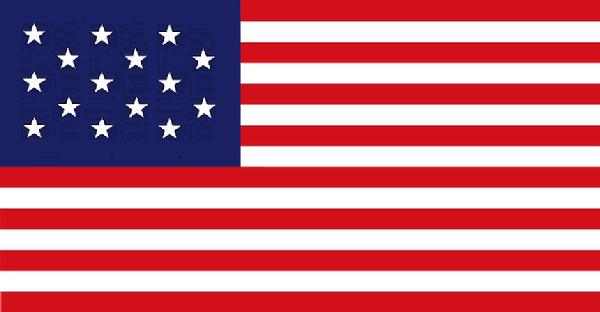 |
| Vermont (March 4, 1791) and Kentucky (June 1, 1792) |
|
|
With the addition of Vermont in 1791 and Kentucky the following year, Congress decided that the U.S. flag should have two additioinal stripes and two additional stars to recognize the new states.
In 1793, the Senate passed a bill increasing the number of stars and stripes to 15. The House was not so easy to convince, however. There were opponents to the legislation who noted, for example, that replacing all flags aboard our naval vessels would cost $60 each. Massachusetts Rep. Benjamin Goodhue feared that the legislation would mandate changes to our flag with each state or group of states. He was right!
The House eventually passed the bill by a vote of 50 to 42. Starting on May 1, 1795 our flag would sport fifteen stars and fifteen stripes.
In her book, "The Star-Spangled Banner" (2003, National Geographic Society), author Margaret Sedeen wrote, "This was the flag that flew on American ships during hostilities with France from 1798 to 1801. In 1803 it was raised over New Orleans after the Louisiana Purchase. It was the flag carried on the western explorations of Lewis and Clark and Zebulon Pike." Indeed, it was the 15-star design that flew during a bombardment of Fort McHenry by the British in 1814, that inspired 35-year old Baltimore lawyer Francis Scott Key to write a poem that would become our national anthem.
The fifteen-stripe design lasted twenty-three years, until 1818, when new 20-star design was introduced. The new design included a return to 13 stripes. More on that in the next installment . . .
Hamden First Selectmen: Ezra Ives (1795), John Hubbard (1796), Hezekiah Dickerman (1797), Caleb Alling (1798), Isaac Dickerman (1799), Philemon Potter (1800-01), Alvin Bradley (1802-04), Amasa Bradley (1805), Chauncey Dickerman (1806), Russell Pierpont (1807-08), Levi Gorham (1809), Hezekiah Warner (1810-11), Jared Atwater (1812), Daniel Chatterton (1813-14), Joel Ford, (1815), Justis Humiston (1816) and Zodac Allen (1817-18).
|
_______________________________________________________________________________________________________
|
13 Stars
(June 14, 1777 - May 1, 1795)
|
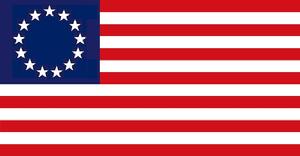 |
| "Betsy Ross" Design |
|
|
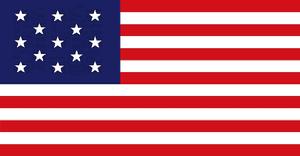 |
| Official government design |
|
|
Delaware, Pennsylvania, New Jersey, Georgia, Connecticut, Massachusetts,
Maryland, South Carolina, New Hampshire, Virginia, New York,
North Carolina, and Rhode Island.
|
As legend has it, Betsy Ross created our first flag with thirteen white five-point stars arranged in a circle on a blue field, and thirteen alternating red and white stripes to represent the thirteen original colonies that became our first thirteen states. This is the design that most of us associate with the original flag. However, the arrangement of the 13 stars on the U.S. flag as officially adopted by the government was actually arranged in ranks and files (3-2-3-2-3), as has been the case on all subsequent designs.
Until the 49-star design was adopted by the government in 1959, there was no "official" design. Many flag makers, particularly those in the 18th and 19th centuries, often chose their own configuration of star arrangements in the union.
The 13-star design as adopted in 1777 represented the United States of America through the entire era of the Articles of Confederation and eight years into the Constitution era.
Regardless of the number of stars, no official U.S. flag is ever obsolete. And no single star in the union represents any one state.
Hamden First Selectmen: John Hubbard (1786-87), Theophilus Goodyear (1788), Medad Atwater (1789), Isaac Dickerman (1790-91), Joel Ford (1792), Theophilus Goodyear (1793), Simeon Bristol (1794) and Ezra Ives (1795).
|
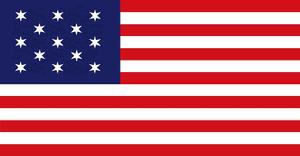 |
| "Hopkinson" version - 1777-1795 |
|
|
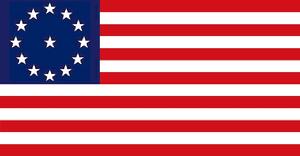 |
| "Cowpence" Flag |
|
|
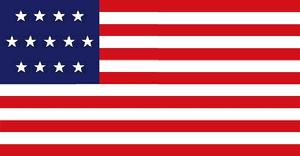 |
| 4-5-4 pattern was very popular during the Revolutionary War. |
|
|
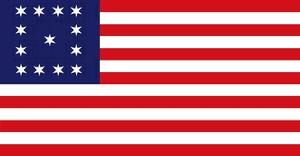 |
| 12 stars in a square with one in the center as depicted in a famous painting by by John Trumbull |
|
|
|